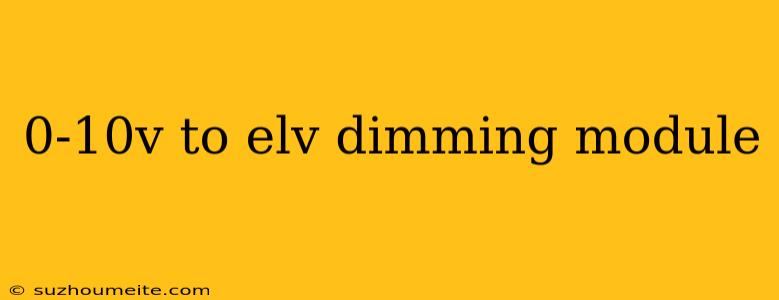0-10V to ELV Dimming Module: Understanding the Technology
Introduction
In the world of lighting control, dimming modules play a crucial role in regulating the intensity of light sources. Among various types of dimming modules, 0-10V to ELV (Extra Low Voltage) dimming modules are widely used in commercial and residential applications. In this article, we will delve into the technology behind 0-10V to ELV dimming modules, their features, and applications.
What is a 0-10V Dimming Module?
A 0-10V dimming module is a device that receives a 0-10V DC control signal and converts it into a suitable signal to control the brightness of a light source. The 0-10V signal is a standardized protocol used in building automation systems to control lighting, HVAC, and other equipment. The module acts as an interface between the control system and the light source, enabling smooth and precise dimming.
What is ELV Dimming?
ELV (Extra Low Voltage) dimming refers to the process of reducing the voltage supplied to a light source to decrease its brightness. ELV dimming is typically used with electronic low-voltage (ELV) transformers, which step down the mains voltage to a lower voltage, usually 12V or 24V, to power the light source. ELV dimming modules are designed to work with these transformers, providing a safe and efficient way to control lighting levels.
How Does a 0-10V to ELV Dimming Module Work?
A 0-10V to ELV dimming module typically consists of the following components:
- Input Stage: Receives the 0-10V DC control signal from the control system.
- Conversion Stage: Converts the 0-10V signal into a PWM (Pulse Width Modulation) signal or a digital signal that the ELV transformer can understand.
- Output Stage: Drives the ELV transformer, regulating the voltage supplied to the light source.
When the control system sends a 0-10V signal to the module, it interprets the signal and adjusts the output voltage to the ELV transformer accordingly. The transformer then supplies the corresponding voltage to the light source, resulting in the desired level of brightness.
Features and Benefits
0-10V to ELV dimming modules offer several advantages, including:
- Smooth Dimming: Provides a smooth and continuous dimming experience, unlike traditional switching methods.
- Energy Efficiency: Reduces energy consumption by minimizing the voltage supplied to the light source.
- Flexibility: Compatible with a wide range of ELV transformers and light sources.
- Reliability: Offers a high level of reliability and durability, reducing the need for frequent maintenance.
Applications
0-10V to ELV dimming modules are commonly used in various applications, including:
- Commercial Lighting: Offices, hotels, and retail spaces where dimming is essential for ambiance and energy efficiency.
- Residential Lighting: Homes and apartments where dimming is desired for comfort and energy savings.
- Theatrical Lighting: Theaters, concert halls, and performance venues where precise dimming is critical for optimal lighting effects.
Conclusion
In conclusion, 0-10V to ELV dimming modules play a vital role in lighting control systems, providing a reliable and efficient way to regulate lighting levels. By understanding the technology behind these modules, architects, engineers, and building managers can design and implement effective lighting control systems that enhance the ambiance, comfort, and energy efficiency of buildings.
